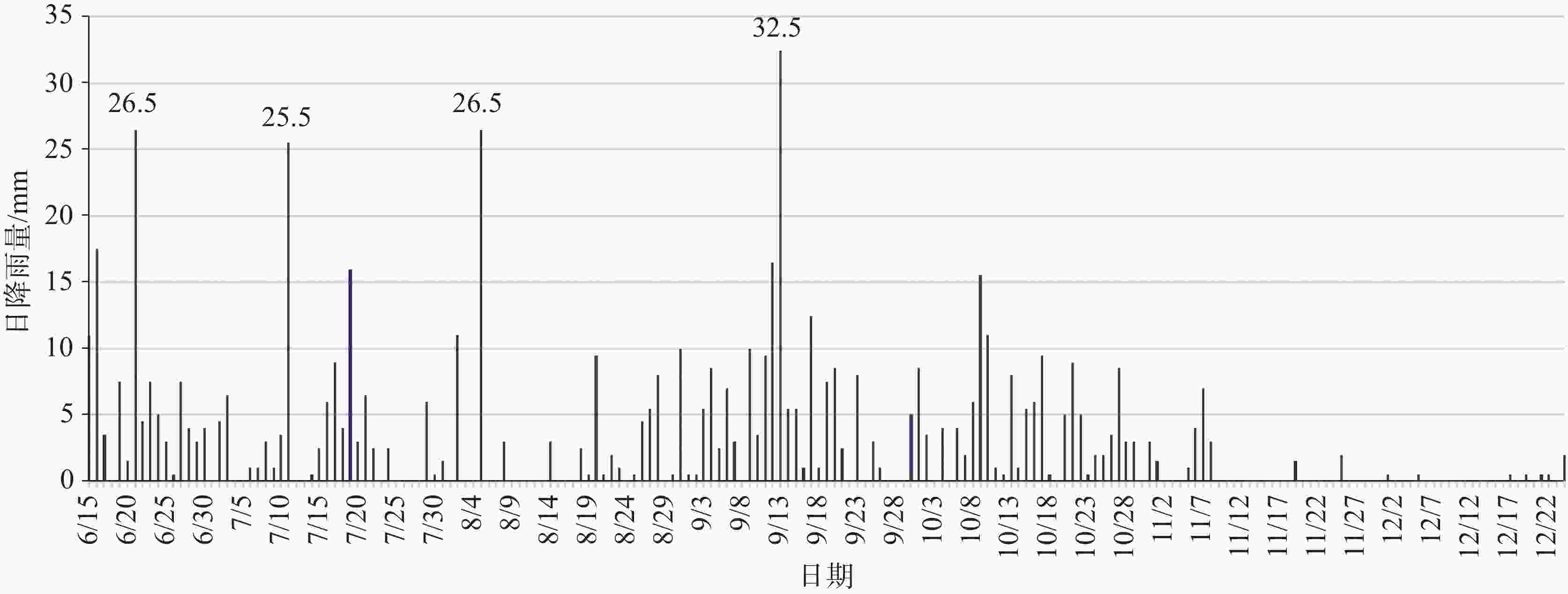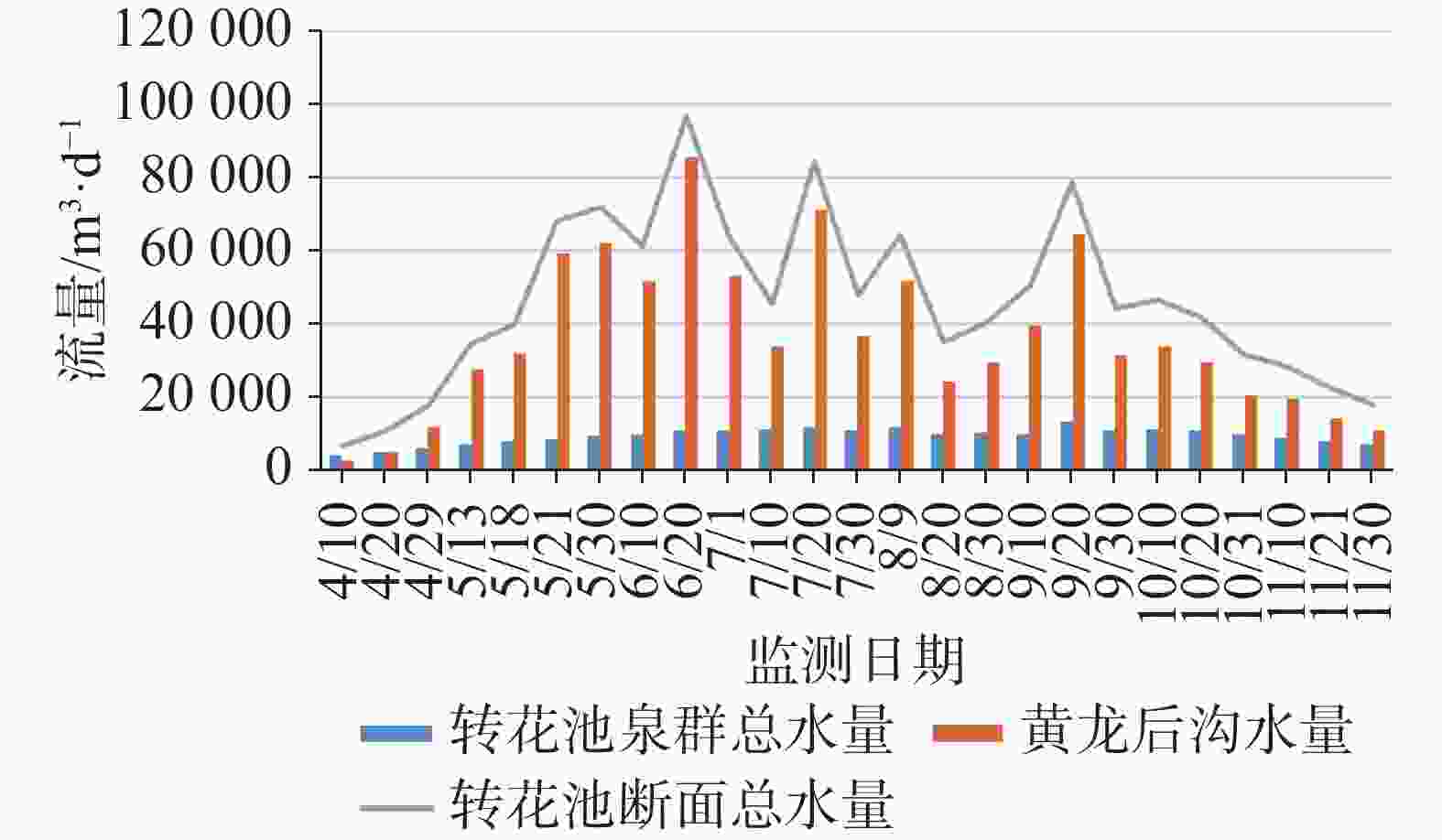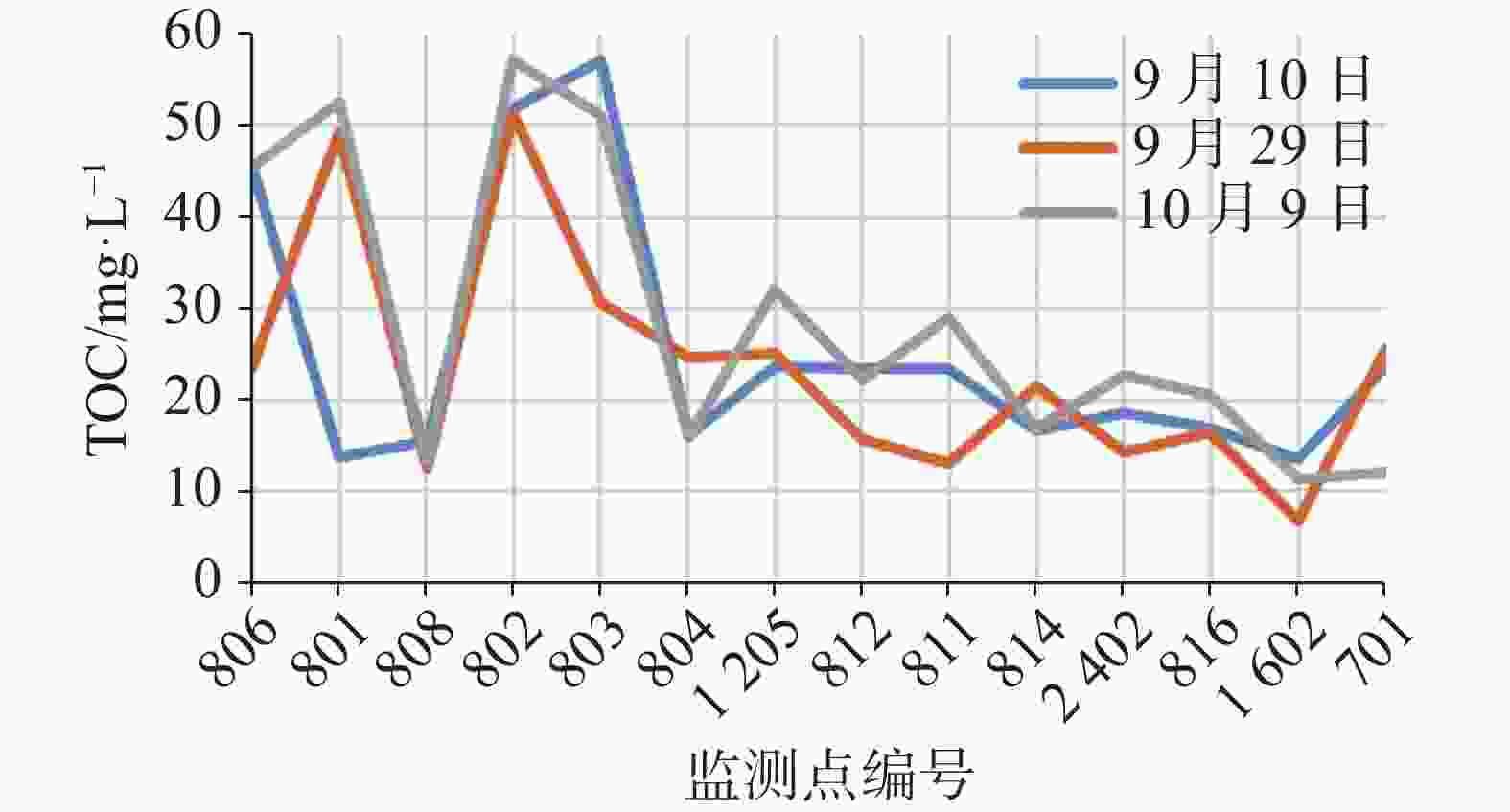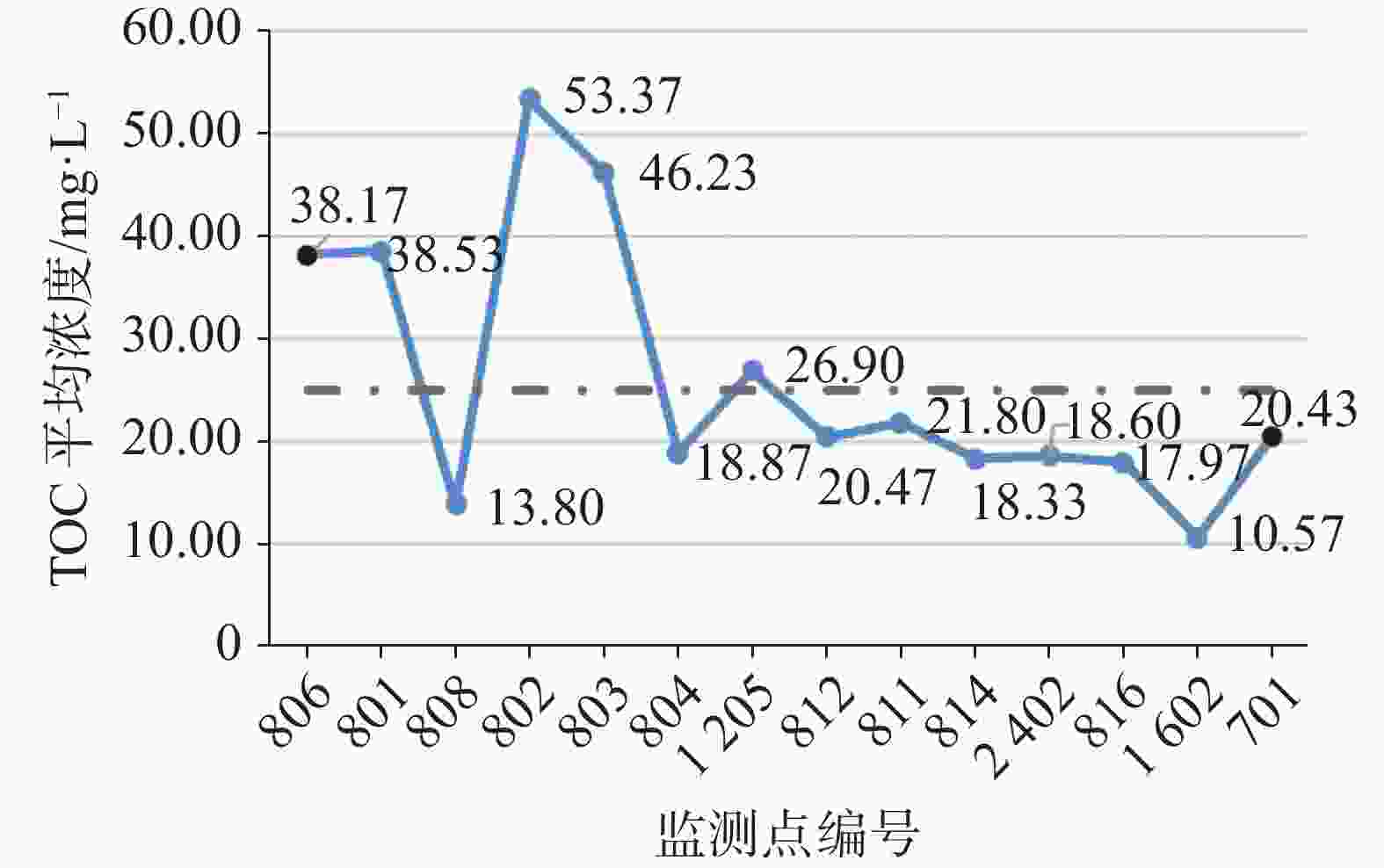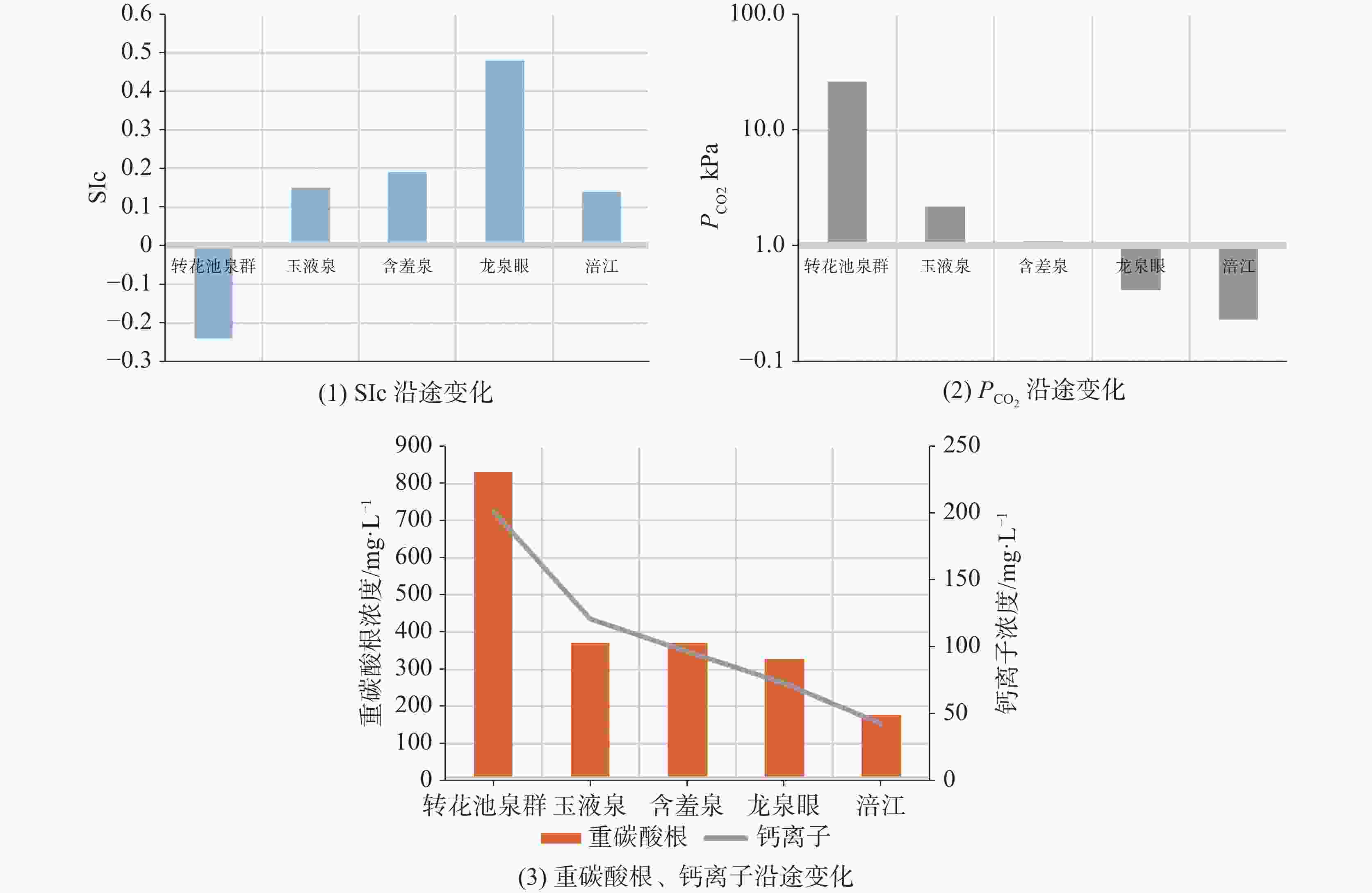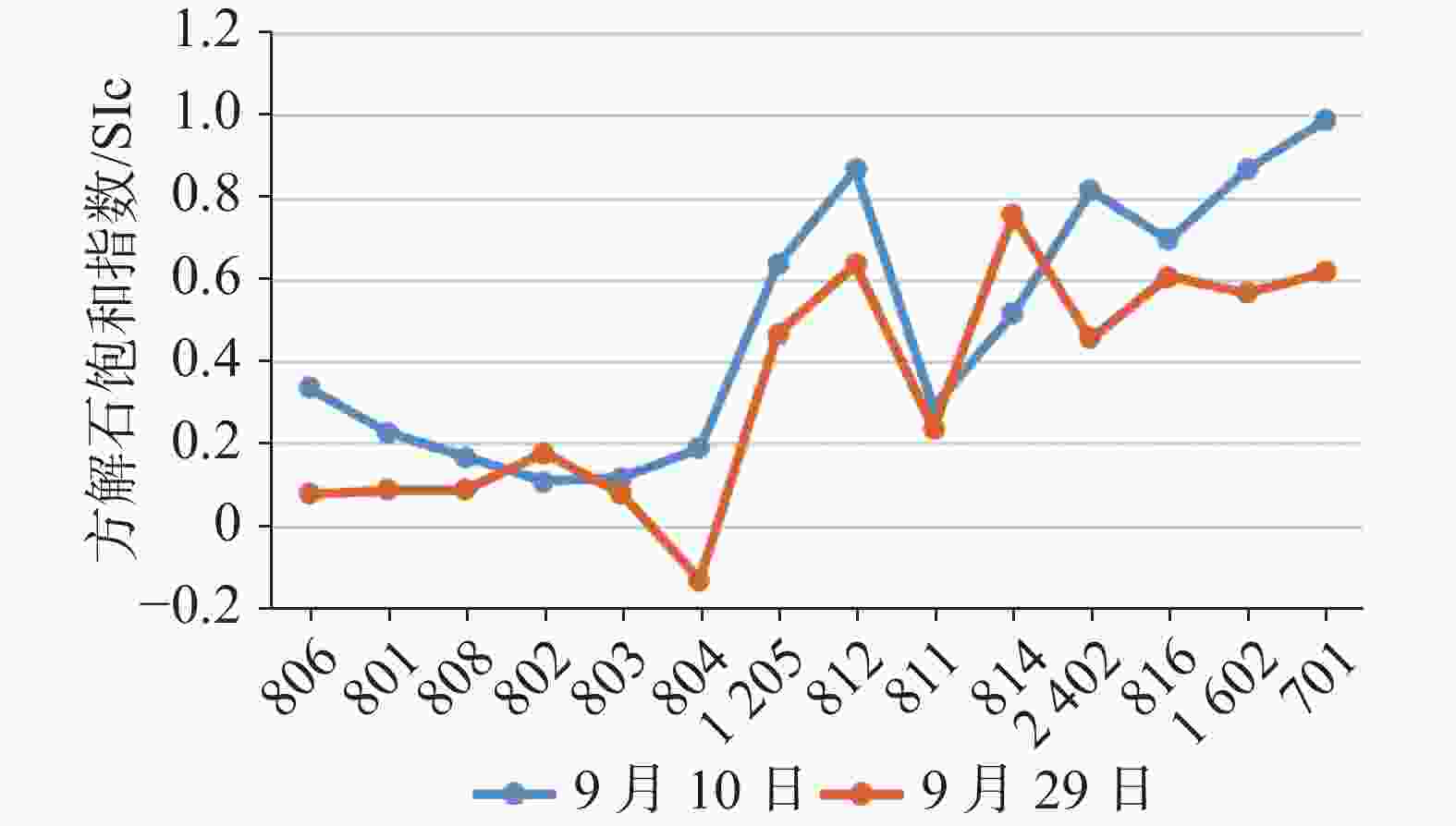Analysis of water environment dynamic characteristics and travertine deposition capacity in Huanglong core scenic spots
-
摘要: 为有效地评估四川黄龙核心景区水体水化学环境、钙华沉积能力,及时掌握景区水体水化学场的变化特征,采用野外实地调查、水质监测等方法,分析转花池泉群的水环境特征,黄龙核心景区的钙华沉积能力及其水环境状况。研究结果表明:①转花池泉群是提供区内钙华沉积的主要钙源和碳源,与黄龙后沟地表水一同构成驱动区内钙华景观发育演化的水源;黄龙沟和转花池泉群的水量补给来源主体分别为降雨和冰雪融水。②1999年以来,转花池泉群流量总体稳中有增,水质极为稳定,近30年来历史最大水量出现在2020年,1999—2017年转花池多年日平均水量为7 817 m3·d−1,2018—2020年多年日平均流量为9 368 m3·d−1。③2018年转花池一带出现线状TOC异常带,主要原因是黄龙沟上游三道坪至头道坪一带的放牧活动造成钙华沉积速率下降,因此,建议加强对钙华源泉涵养区的保护,减少放牧活动对其的影响。④区内各水循环段的景观水仍具备一定的沉积能力,2019年SIc值下降,与强降雨的稀释作用有关,从而降低了钙华沉积能力。Abstract:
The Huanglong scenic area, a World Natural Heritage, is located in the east of Songpan county, Aba Xizang and Qiang Autonomous Prefecture, Sichuan Province. It is a typical landscape plateau of cold-water travertine. Water in travertine landscape, as the most important carrier, controls the formation and evolution of travertine. Yuan Daoxian, Liu Zaihua, et al., from Institute of Karst, Chinese Academy of Geoscience, studied the source, sedimentary mechanism and influencing factors of the sedimentary process of travertine, which laid the foundation for the geological study of Huanglong travertine. In recent years, affected by the increasing human activities, the water environment in the Huanglong scenic area has deteriorated, resulting in local degradation of travertine landscape. Therefore, this study has been conducted to effectively assess the hydrochemical environment and the deposition capacity of travertine in Huanglong core scenic spots, and to analyze the change characteristics of hydrochemical field in these spots, thus providing corresponding support for the subsequent research on technology of travertine landscape conservation. The research area covers all the core scenic spots of Huanglong, from Zhuanghua pool to Fujiang river. In this study, field investigation, water quality monitoring, flow monitoring and analysis of historical monitoring data were used to evaluate the water environment and explore its influence on travertine deposition. A total of 14 monitoring sites covers all springs and surface water related to the water cycle. The indexes such as pH, temperature, Ec, Ca2+ and HCO$_3^{−}$ were measured on site. Other indexes of water quality such as PO$_4^{3-}$, Cl−, SO$_4^{2-}$, NO$_3^{−}$, NO$_2^{−}$, NH$_4^{+}$, K+, Na+, Mg2+ and Ca2+ were collected and sent to the laboratory for testing according to requirements. The rainfall and water quantity data before 2017 were provided by Huanglong Scientific Research Office, and the data from 2018 to 2021 were obtained by the authors through long-term monitoring. Research findings show: (1) The Zhuanhuachi springs are the main calcium and carbon source of travertine deposition in the area. They, together with surface water in Huanglong valley, constitute the water source boosting the development and evolution of travertine landscape. The main sources of water recharge for Huanglong valley and Zhuanhuachi springs are rainfall and meltwater of snow. (2) Since 1999, the flow rate of Zhuanhuachi springs has increased steadily and then to the maximum. The water quality is extremely stable with average pH of 6.6, average water temperature of 6.7℃, average Ca2+ of 208 mg·L−1. The SIc is generally in an unsaturated state. The historical maximum water volume in the past 30 years appeared in 2020, with an average daily water volume of 9,998.09 m3·d−1 from April to November. The water volume has experienced a slow downward trend since 2021. From 1999 to 2017, the annual average daily water volume of Zhuanhuachi springs was 7,817 m3·d−1, and the annual variation of the average daily water volume was about ±1,500 m3·d−1. The annual average daily flow from 2018 to 2020 was 9,368 m3·d−1. (3) In 2018, linear TOC anomaly zones appeared in the area of Zhuanhuachi springs, and the main anomaly points occurred at the spring mouths of No.1, No.2, No.4 and No.6. The main reason was the grazing activities from Sandao lawn to Toudao lawn in the upper reaches of Huanglong valley. The manure produced by cattle contained a large amount of organic carbon (about 15%), which dissolved in water under the effect of rainfall leaching. As the water circulation entered the groundwater and migrated to the area of Zhuanhuachi springs, the deposition rate of travertine decreased. The TOC anomaly approximately disappeared at the north of the Zhuanhuachi springs. (4) The core scenic spots of Huanglong experienced rapid degassing from upstream to downstream. SIc increased significantly, and the concentration of HCO$_3^{−}$ decreased considerably in the first cycle. But there was little change in the north of Yuye spring. The decrease of Ca2+ can be divided into two stages. In the first cycle section (from Zhuanhuachi springs to Yuye spring), the concentration of calcium ions decreased obviously, and there were more travertine deposits. The deposition rate of travertine in the lower reaches of Yuye spring was stable, and the ions concentration decreased linearly. (5) Landscape water in each water cycle segment in the area still shows a certain depositional capacity, because the dilution of heavy rainfall reduced the depositional capacity of travertine. The SIc value decreased in 2019. The water environment of Huanglong core scenic spots is stable with a good capacity of travertine deposition, which maintains spring overflow, strong degassing and rapid deposition. Influenced by animal husbandry and rainfall, the deposition capacity of travertine decreased slightly. It is suggested to strengthen the protection for the conservation area of travertine spring source and reduce the influence of grazing activities on it. -
表 1 监测站点一览表
Table 1. List of monitoring sites
序号 监测站编号 监测对象 流量监测类型 水体类型 监测站与监测对象关系 位置 1 806 转花池1号泉 矩形堰 地下水 泉口下游河道 转花池 2 801 转花池2号泉 三角堰 地下水 泉口 3 808 转花池3号和5号泉 矩形堰 地下水 泉口下游河道 4 802 转花池4号泉 三角堰 地下水 泉口 5 803 转花池6号泉 三角堰 地下水 泉口 6 804 黄龙后沟地表水 矩形堰 地表水 溪流 核心景区上游 7 1205 黄龙沟东坡泉群 矩形堰 地下水 泉群下游坡脚 8 812 接仙桥大泉 矩形堰 地下水 泉口下游河道 核心景区中游 9 811 玉液泉 矩形堰 混合水 泉口 10 814 含羞泉 矩形堰 地下水 泉口 11 2402 隐芳泉 矩形堰 混合水 泉口下游 12 816 龙泉眼 矩形堰 混合水 泉口 核心景区下游 13 1602 涪源桥桥下涪江溪水 流速仪 地表水 溪流 14 701 四号停车场旁涪江溪水 流速仪 混合水 溪流 表 2 转花池泉水水质动态
Table 2. Water quality dynamics of Zhuanhuachi springs
野外监测
(年/月/日)pH 水温
t/℃电导率
μs·cm−1[Ca2+]
mg·L−1[${\rm{HCO}}_3^{-}$]
mg·L−1$P_{{\rm{CO}}_2} $
kPaSIc 2018/9/10 6.7 6.8 1 078 248 746 10.25 0.15 2018/9/29 6.7 6.8 1 091 224 746 10.28 0.12 2018/10/21 6.6 6.7 1 093 / 746 15.00 −0.83 2019/4/20 6.5 6.2 1 163 228 715 18.09 −0.17 2019/5/21 6.6 6.3 / 188 873 15.00 0.01 2019/6/20 6.6 6.5 / 192 899 17.28 −0.02 2019/7/20 6.4 7.2 1 144 202 831 26.70 −0.24 2019/9/20 6.5 6.8 1 101 182 746 16.40 −0.16 2020/6/5 6.4 6.7 1 203 175 856 12.80 0.04 2020/7/20 6.6 7 1 182 211 823 15.30 0 2020/10/20 6.7 6.5 1 114 227 812 11.90 0.11 表 3 总有机碳(TOC)测试结果(2018年)
Table 3. Test results of total organic carbon (TOC) in 2018
编号 位置 SIc TOC/mg·L−1 9月10日 9月29日 9月10日 9月29日 10月9日 806 转花池1号泉 0.34 0.08 45.7 23.5 45.3 801 转花池2号泉 0.23 0.09 13.8 49.2 52.6 808 转花池3号和5号泉 0.17 0.09 15.4 12.6 13.4 802 转花池4号泉 0.11 0.18 51.7 51.4 57.0 803 转花池6号泉 0.12 0.08 57.0 30.7 51.0 804 黄龙后沟地表水 0.19 −0.13 16.2 24.5 15.9 1205 黄龙沟东坡泉群 0.64 0.47 23.7 25.0 32.0 812 接仙桥大泉 0.87 0.64 23.4 15.7 22.3 811 玉液泉 0.29 0.24 23.4 13.0 29.0 814 含羞泉 0.52 0.76 16.6 21.4 17.0 2402 隐芳泉 0.82 0.46 18.7 14.3 22.8 816 龙泉眼 0.70 0.61 17.0 16.4 20.5 1602 涪源桥桥下溪水 0.87 0.57 13.5 6.8 11.4 701 四号停车场旁溪水 0.99 0.62 23.6 25.5 12.2 表 4 钙华沉积能力主要指标(丰水期)
Table 4. Main indexes of travertine deposition capacity in the wet season
序号 水体 SIc $P_{{\rm{CO}}_2} $/kPa ${\rm{HCO}}_3^{-}$ /mg·L−1 Ca2+ /mg·L−1 1 转花池泉群 −0.24 26.70 831 202.0 2 黄龙沟 −0.06 2.00 278 212.0 3 五彩池入口 0.24 7.30 790 194.0 4 东坡泉群 0.39 4.30 740 183.0 5 接仙桥地表水 0.20 1.20 401 95.0 6 玉液泉 0.15 2.20 370 121.0 7 隐芳池 0.46 0.97 494 83.1 8 含羞泉 0.19 1.10 370 96.9 9 龙泉眼 0.48 0.41 327 73.3 10 涪江 0.14 0.23 176 43.0 -
[1] 刘再华, 田友萍, 安德军, 王海静, 唐淑, 张金流, 孙海龙, 刘彦, 张清明. 世界自然遗产−四川黄龙钙华景观的形成与演化[J]. 地球学报, 2009, 30(6):841-847.LIU Zaihua, TIAN Youping, AN Dejun, WANG Haijing, TANG Shu, ZHANG Jinliu, SUN Hailong, LIU Yan, ZHANG Qingming. Formation and evolution of the travertine landscape at Huanglong, Sichuan, one of the World Natural Heritages[J]. Acta Geoscientia Sinica, 2009, 30(6):841-847. [2] 刘再华, 袁道先, W Dreybrodt, U Svesson. 四川黄龙钙华的形成[J]. 中国岩溶, 1993, 12(3):185-191.LIU Zaihua, YUAN Daoxian, W Dreybrodt, U Svesson. The formation of tufa in Huanglong, Sichuan[J]. Carsologica Sinica, 1993, 12(3):185-191. [3] 刘再华, 游省易, 李强, 张美良. 云南白水台钙华景观的水化学和碳氧同位素特征及其在古环境重建研究中的意义[J]. 第四纪研究, 2002, 22(5):459-467.LIU Zaihua, YOU Shengyi, LI Qiang, ZHANG Meiliang. Hydrochemical and isotopic characteristics of tufa in the Baishuitai scenic area of Yunnan and their implications for paleoenvironment reconstruction[J]. Quaternary Sciences, 2002, 22(5):459-467. [4] 刘再华, 袁道先, 何师意, 曹建华, 游省易, W Dreybrodt, U Svensson, K Yoshimura, R Drysdale. 四川黄龙沟景区钙华的起源和形成机理研究[J]. 地球化学, 2003, 32(1):1-10.LIU Zaihua, YUAN Daoxian, HE Shiyi, CAO Jianhua, YOU Shengyi, W Dreybrodt, U Svensson, K Yoshimura, R Drysdale. Origin and forming mechanisms of travertine at Huanglong ravine of Sichuan[J]. Geochimica, 2003, 32(1):1-10. [5] 姜泽凡, 刘艳梅, 胥良. 黄龙钙华景观形成及演化趋势研究[J]. 水文地质工程地质, 2008, 35(1):107-111, 116.JIANG Zefan, LIU Yanmei, XU Liang. A study of the formation and evolution trend of the Huanglong travertine landscape[J]. Hydrogeology & Engineering Geology, 2008, 35(1):107-111, 116. [6] 刘海生, 周训, 张彧齐, 海阔,余鸣潇,谭梦如,尚子琦. 温泉钙华沉积的影响因素[J]. 中国岩溶, 2020, 39(1):11-16.LIU Haisheng, ZHOU Xun, ZHANG Yuqi, HAI Kuo, YU Mingxiao, TAN Mengru, SHANG Ziqi. A brief review on the factors affecting deposition of travertines in hot springs[J]. Carsologica Sinica, 2020, 39(1):11-16. [7] Fouke B W. Hot-spring systems geobiology: Abiotic and biotic influences on travertine formation at Mammoth hot springs, Yellowstone National Park, USA[J]. Sedimentology, 2011, 58(1):170-219. doi: 10.1111/j.1365-3091.2010.01209.x [8] 董发勤, 代群威, 饶瀚云, 王富东, 赵学钦, 蒋忠诚, 张强, 李博文, Alexander I Malov, Enrico Capezzuoli, Augusto Auler. 黄龙与黄石钙华微生物沉积作用比较研究[J]. 中国岩溶, 2021, 40(2):264-272.DONG Faqin, DAI Qunwei, RAO Hanyun, WANG Fudong, ZHAO Xueqin, JIANG Zhongcheng, ZHANG Qiang, LI Bowen, Alexander I Malov, Enrico Capezzuoli, Augusto Auler. Comparative study on microbial deposition of travertine in Huanglong scenic area and Yellowstone National Park[J]. Carsologica Sinica, 2021, 40(2):264-272. [9] 赵晓夏, 李琼芳, 董发勤, 代群威, 宋娜, 董鹏举, 崔杰, 罗尧东, 张强, Xin Zhang, O'Driscoll Mike. 雪宝顶流域黄龙“8.8”地震后短内主要水环境变化特征[J]. 中国岩溶, 2021, 40(1):77-87.ZHAO Xiaoxia, LI Qiongfang, DONG Faqin, DAI Qunwei, SONG Na, DONG Pengju, CUI Jie, LUO Yaodong, ZHANG Qiang, Xin Zhang, O'Driscoll Mike. Characteristics of water environment changes in a short period after the "8 August 2017" earthquake in Huanglong, Xuebaoding watershed[J]. Carsologica Sinica, 2021, 40(1):77-87. [10] 石岩. 黄龙水环境特征与钙华景观演化趋势研究[D]. 成都: 成都理工大学, 2005.SHI Yan. Study on the hydro-environmental characteristics and travertine evolution at Huanglong area[D]. Chengdu: Chengdu University of Technology, 2005. [11] 卢国平. 四川黄龙-九寨自然风景区冷水型钙华成因的水文地球化学研究[J]. 矿物岩石, 1994, 14(3):71-78.LU Guoping. Hyrdrogeochemical research of cold-water travertine in Huanglong-Jiuzhai scenic spots, Sichuan Province[J]. Journal of Mineralogy and Petrology, 1994, 14(3):71-78. [12] 袁道先. 碳循环与全球岩溶[J]. 第四纪研究, 1993(1):1-6.YUAN Daoxian. Carbon cycle and global karst[J]. Quaternary Sciences, 1993(1):1-6. [13] 袁道先. “岩溶作用与碳循环”研究进展[J]. 地球科学进展, 1999, 14(5):425-432.YUAN Daoxian. Progress in the study on karst processes and carbon cycle[J]. Advances in Earth Science, 1999, 14(5):425-432. [14] 胥良, 姜泽凡, 李前银. 黄龙钙华景观演化特征及保护措施探讨[J]. 地质灾害与环境保护, 2007, 18(4):79-84.XU Liang, JIANG Zefan, LI Qianyin. Study on characters of evolution and protection measures of Huanglong calc-sinter landscape[J]. Journal of Geological Hazards and Environment Preservation, 2007, 18(4):79-84. [15] 姜泽凡, 胥良, 张文彬. 黄龙钙华水来源研究[J]. 地质灾害与环境保护, 2007, 18(3):72-75.JIANG Zefan, XU Liang, ZHANG Wenbin. Study on source of Huanglong calc-sinter water[J]. Geological Hazards and Environment Preservation, 2007, 18(3):72-75. [16] 王海静. 四川黄龙沟钙华沉积溪流的水化学和同位素的时空变化研究[D]. 重庆: 西南大学, 2009.WANG Haijing. Study on the spatio-temporal variations of hydrochemistry and stable isotopes at Huanglong in Sichuan, China[D]. Chongqing: Southwest University, 2009. [17] 刘馨泽, 孙东, 曹楠, 袁楠楠, 黄何平, 田长宝, 张清明, 唐淑, 李大猛, 周大吉, 董发勤. 黄龙核心景区多层级水循环系统结构研究[J]. 中国岩溶, 2021, 40(1):19-33. doi: 10.11932/karst20210103LIU Xinze, SUN Dong, CAO Nan, YUAN Nannan, HUANG Heping, TIAN Changbao, ZHANG Qingming, TNG Shu, LI Dameng, ZHOU Daji, DONG Faqin. Study on the structure of multi-layer water circulation system in the core scenic spot of Huanglong[J]. Carsologica Sinica, 2021, 40(1):19-33. doi: 10.11932/karst20210103 [18] 万新南, 杨菊, 程温莹, 罗丽, 安德军, 唐淑, 台永东. 四川黄龙景区“源水”成因浅析[J]. 成都理工大学学报(自然科学版), 2010, 37(1):91-95.WAN Xinnan, YANG Ju, CHENG Wenying, LUO Li, AN Dejun, TANG Shu, TAI Yongdong. Headwater origin analysis in the Huanglong scenic spot, Sichuan, China[J]. Journal of Chengdu University of Technology (Science & Technology Edition), 2010, 37(1):91-95. [19] 张金流, 鲍祥. 溶解有机碳对黄龙钙华沉积的影响[J]. 安庆师范大学学报(自然科学版), 2017, 23(1):78-82.ZHANG Jinliu, BAO Xiang. Quantitative study on effects of dissolved organic carbon on travertine depositions rate at Huanglong scenic spot[J]. Journal of Anqing Normal University (Natural Science Edition), 2017, 23(1):78-82. [20] 王海静, 刘再华, 曾成, 刘香玲, 孙海龙, 安德军, 唐淑, 张清明. 四川黄龙沟源头黄龙泉泉水及其下游溪水的水化学变化研究[J]. 地球化学, 2009, 38(3):307-314. doi: 10.19700/j.0379-1726.2009.03.010WANG Haijing, LIU Zaihua, ZENG Cheng, LIU Xiangling, SUN Hailong, AN Dejun, TANG Shu, ZHANG Qingming. Hydrochemical variations of Huanglong spring and the stream in Huanglong ravine, Sichuan Province[J]. Geochimica, 2009, 38(3):307-314. doi: 10.19700/j.0379-1726.2009.03.010 -





 下载:
下载:

